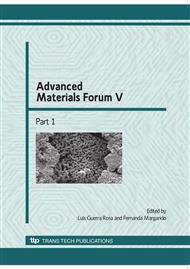p.307
p.315
p.325
p.332
p.338
p.344
p.348
p.356
p.361
Influence of Oxygen Stoichiometry and Cation Ordering on Magnetoresistive Properties of Sr2FeMoO6±δ
Abstract:
This work investigates the influence of initial compound synthesis prehistory on the phase sequence during formation of single-phase Sr2FeMoO6 (SFMO). Analytical-grade SrCO3, Fe2O3 and MoO3 (sample No.1) and partially reduced precursors of SrFeO3-x (SFO) and SrMoO4-y (SMO) (sample No.2) were used as initial reagents. In the latter case, kinetic limitations of SFMO phase formation are resolved by increasing the diffusivity of both of Fe3+ and Mo5+ and decreasing diffusion lengths to the reaction zone. This enhances the double-perovskite growth rate, lowers synthesis temperature and increases the intensity of X-ray reflections of (011) and (013) planes suggesting a superstructural ordering of Fe3+ and Mo5+ cations. Samples No.1 and No.2 have both a Тс ~ 420K while the magnetization value at 77 K in the sample No.2 is higher by a factor 2.3 compared to that of sample No.1. A decrease of the oxygen vacancy concentration by annealing Sr2FeMoO5.82 lowered magnetization of the samples and promoted the formation of a second magnetic phase with Тс = 700 К. We suppose that an increase of oxygen partial pressure during annealing causes formation of clusters with antiferromagnetic coupling in Fe3+-О2--Fe3+ chains. In order to increase the magnetoresistive effect at temperatures relevant for technical application, weak intergrain bonds should be formed.
Info:
Periodical:
Pages:
338-343
Citation:
Online since:
January 2010
Authors:
Price:
Сopyright:
© 2010 Trans Tech Publications Ltd. All Rights Reserved
Share:
Citation:


